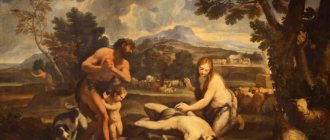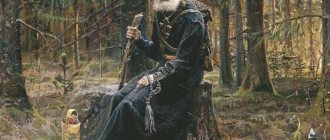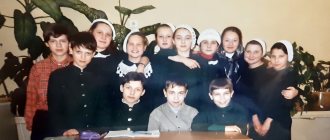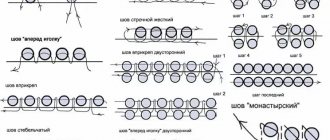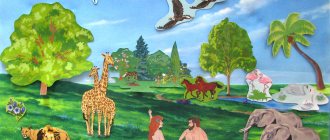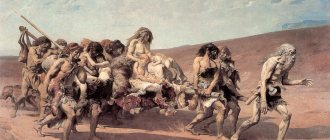Thematic lesson: Cain and Abel
Many were looking forward to the long-awaited continuation of our Bible themed classes.
I am pleased to offer you our lesson on the topic “Cain and Abel”. The topic is serious, but interesting and useful. At first I wanted to put more emphasis on vegetables, but during the preparation process I realized that it was important to equally show both the work of Cain and Abel, as well as their relationship. This is how many interesting tasks appeared. Flannelograph "Cain and Abel". First we played the story of Cain and Abel on a flannelograph. I have already talked about its production earlier. Dima was so happy about the new characters, he was always in a hurry to attach them to the flannelgraph ahead of the text. If anyone is interested and needs it, you can download the figures and the script for the story itself here.
Then, as I promised, I did mixed tasks between vegetables and sheep - Cain's farming and Abel's livestock farming. First, we arranged the toy vegetables into pictures with the names of the vegetables - this is the World in the Palm set “What grows in the garden.” I made models of vegetables using the papier-mâché technique. (You can also use real vegetables). This includes a comparison of a drawing and a three-dimensional figure, and reading practice. Dima laid out everything flawlessly! Mysterious bag . She gave him the task of putting all the vegetables in a bag, and then suggested that he determine by touch what was there. Dimka could not name many vegetables correctly. Still, it’s difficult to determine by touch. But he liked doing the task, and was especially happy when he guessed the vegetables.
Colored sheep. She cut out the heads of colored sheep and invited Dimka to put them on the same color, and at the same time they repeated their names. The game is not difficult, but interesting.
Count the vegetables. On the cards with the quantities of vegetables, Dima happily attached clothespins to the number whose number of vegetables is shown in the picture. He snatched this task from me himself. Attach clothespins. This task is also with clothespins, but more artistic. I pre-printed the drawings on thick paper and pasted them onto cardboard. I cut out drawings around the office. The task is to attach green clothespins to vegetables: onions, carrots, turnips and radishes, like tops. Attach clothespins to the sheep like legs. Sheep can even be placed on these legs. Dimka really liked the animated sheep! He ran with them all over the room. I decided to use the resulting vegetables and sheep for our altars.
Altars. Altars were built from the available cubes. We only have Zaitsev cubes at home, but I was glad that they came in two colors. We decided to build two altars of different colors: one from iron (gray) cubes, and the other from wooden (brown) cubes. And they put vegetables on one, and a sheep with clothespins on the other. It was also possible to post the names of the characters, but this idea came to me later.
Cut out pictures. I printed out and cut the blank drawings into separate tasks. Dimka really loves these cutouts now, so I made so many of them. Carving vegetables and sheep according to the tasks was very interesting. The only thing was that the sheep was without its curls, so that Dimka would not be upset, I immediately remembered and told him that sheep are sometimes sheared and mittens, socks, etc. are made from wool.
Physical exercise. We had a fun time, jumping together to the text of a funny poem. We jumped several times - Dimka liked it so much.
Two cheerful sheep frolicked near the river Jump-skok, jump-skok (We jump, holding hands) Two cheerful sheep early in the morning near the river Jump-skok, jump-skok (We jump, holding hands) Up to the sky (raise our hands high) Down to the grass (we lower our hands to the floor) Up to the sky (we raise our hands high) Down to the grass (we lower our hands to the floor) And then we spun, we spun (we hold hands and we spin) Bang! We fell into the river (we fall)
Combine identical vegetables. Attention development task and writing practice. We have already remade a lot of these options, but Dimka always likes them. Find the odd one out. Dima easily found everything except carrots - he had to pay attention to the tops. And it’s nice that he always justified his choice. Memory vegetables. As always, we tried to break the rules of the memory game, but Dimka dealt with it as best he could.
Find the fragments. Dima found almost everything with ease, only the tree and the last picture confused him, but we reasoned together and managed it. At the same time, they repeated the names of geometric shapes. Puzzles "Cain and Abel". I printed it out on thick paper and pasted it onto cardboard. I let it dry in the sheets of a thick book. Carefully cut out all the details. She placed the round centers on the table in front of Dima. We read who where and then selected the corner parts for the brothers that were typical for them. We reasoned with him when he found it difficult to choose. But the game worked! Answer the questions. She offered Dima questions and answers based on the pictures. We traced them with a pencil and connected them, but we don’t know how to write numbers yet, so I helped.
Game "Emotions of the First People". First, I put two large cards about Adam and Eve in front of Dima, and he read the names of the emotions and matched them with pictures. Then she placed the cards about Cain and Abel in the same way. Dimka did a very good job! Board game "Cain and Abel". This game used regular chips and a die from another game. Stopping at the pictures, they discussed what was depicted in them. I haven’t used the offer cards yet, I’ve left them for the future. A book with practical tasks “Cain and Abel”. I printed book pages on both sides of each sheet, folded the sheets and got a booklet in A-5 format. We used it as a repetition and reinforcement of all the material covered. Dima read the sentences in the book, which were specially written for children, simply and large. He refused to color the pictures, with the exception of vegetables, but completed the assignments with joy.
Sheep craft. You can find many options on the Internet, but somehow I didn’t like anything based on our age - either it’s very simple, or it’s already complicated. We already made a flat drawing of a lamb once, I wanted a three-dimensional craft. And this is what I came up with. A roll of toilet paper, two plugs were glued in advance while we were walking - it dried out. And then Dima glued lumps of cotton wool onto the resulting “reel” - he did it with great pleasure. A cotton tail and muzzle were glued to the top of the plugs. This is such a soft miracle we got.
You can download all materials created and used by me here.
You might be interested in:
Games with clothespins
Thematic lesson: The fourth day of creation
Adam's Animal ABC
Lesson summary “Cain and Abel”
Dvornyakova O.V.
Required materials: lesson notes, Children's Bible, story about Tomato and Potato.
1.Greeting.
2. Repetition of what has been covered.
Teacher In the last lesson we talked about the first people - Adam and Eve. Remember what happened to them in the Garden of Eden?
The children ate an apple... and disobeyed God...
TeacherAdam and Eve committed the first sin on earth - they sinned by disobedience. How did the Lord punish them for this?
He expelled the children from paradise, they became mortal, and the Lord also said that people would work to earn their own food.
Teacher Let's find out what happened to them next...
3. New material.
Educator A lot of time passed after Adam and Eve were expelled from paradise. They had two sons - Cain and Abel. Adam and Eve loved their sons very much. The boys grew up and became handsome young men. Abel tended sheep, and Cain was a farmer, that is, he grew vegetables and fruits.
One day Adam said to his sons: “The time has come to bring gifts to God.” The young men built altars. Cain put fruits and vegetables on his because he worked in the field and garden, and Abel put the best lamb from the flock that he tended. Each one lit his own altar. Abel’s fire burned brightly, that is, the Lord accepted his sacrifice, but Cain’s fire immediately went out. Then Cain was jealous of his brother that his gift turned out to be pleasing to God, so he lured Abel into the field and killed him there.
The Lord punished Cain for his sin and made him an exile, drove him away.
This is the terrible sin that envy can lead to.
Now, let's listen to a similar story with a different ending, this story is fabulous...
...Once upon a time there were two friends - Tomato and Potato... They grew up in the same garden next to each other. At first Potato and Tomato were friends. But soon Potato, seeing how the Tomato sang and poured, began to envy the Tomato.
- You, Tomato, are always in the fresh air. The sun is browning your sides, the breeze is blowing, and your color is the best - red! And I? I grow underground, in the cold and damp. And they’ll dig me up – straight into a bag and into the basement. There is darkness around me again. My skin is rough, lumpy, and expressionless. The owners admire you, that’s how big and beautiful our Tomato has grown, they say.
“Well, Potato, you pestered me,” Tomato answered her and turned away, “it’s not my fault.”
“Yes,” Potato continued to envy, “they decorate you in salads, in jars for the winter, and even on holiday dishes.” And I am poor and unhappy, no one, no one loves me or notices me, no one respects me.
Then Tomato realized that he shouldn’t be offended by Potato, but he needed to help him see the good qualities in himself.
- Potato, dear, don’t be offended. Honor and praise are always on your table. Do you know how many nutrients you have? Lots and lots. People can't live without you. After all, bread and potatoes are the most important products on the table.
“It’s true,” Potato thought. “I’m healthy and nutritious, and my skin isn’t ugly at all.” Potatoes can be either white or pink. I'm sorry Tomato, if I offended you, I won't envy you anymore. And thank you very much for helping me understand this.
After this, Tomato and Potato became even stronger friends
4. Discussion of new material.
TeacherHow did the Potato feel about the Tomato?
Children With envy, irritation.
Teacher How did the Tomato help the Potato?
Children Told her that she was useful...
Teacher Tomato tried to see in the unsightly potato all its good sides - the benefits that it brings. Tell me, was Potato able to overcome her envy and resentment?
Children Yes.
Teacher In my opinion, guys, this story is very similar to the story of Cain and Abel. Could Cain, like the Potato from our fairy tale, defeat envy in his heart and rejoice with his brother?
Children Could.
Teacher Then Cain would not have committed this terrible act - the murder of his brother Abel. Let us also try to look for the good sides in other people. And if someone does something better than us, then we will fight our envy, like Potato.
5. Prayer.
Teacher And if we nevertheless sinned, envied someone, we will pray to God that He will forgive us. To do this, in the last lesson we learned a prayer, let’s repeat it again, all together: “God, be merciful to me, a sinner.”
6. Homework
Retell two stories to your family - mom, dad, grandmother or friends - the biblical story about Cain and Abel, and the fairy tale about the Tomato and Potato. In the next lesson, tell who you shared your new knowledge with.
Methodological notes:
The teacher needs to take a Children's Bible with him to class and show the children illustrations as the story progresses.
© All rights reserved
Biblical source: Genesis 4:1-16
Call one of the children to show a small experiment with his help. Wrap a regular black thread around the child (torso with arms) and ask him to break the thread and free himself from it. He can easily do this, wrap it a second time several times - it’s harder to break it, wrap it even more - it’s even more difficult to break free. The same thing happens with a bad thought that comes into a person’s mind. At first it is not difficult to drive it away, but if you start thinking about it, if you spin the bad thought further, it will become more and more difficult to free yourself. The Bible talks about what trouble came from the fact that a person did not drive away evil thoughts.
